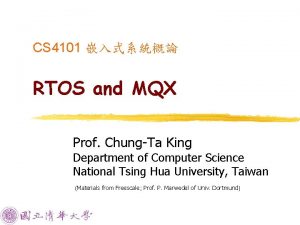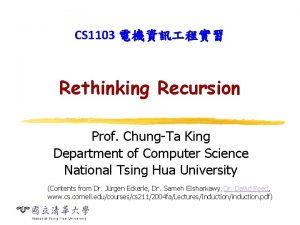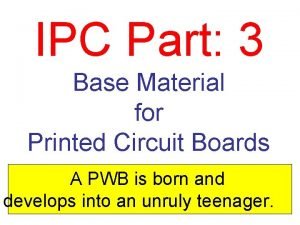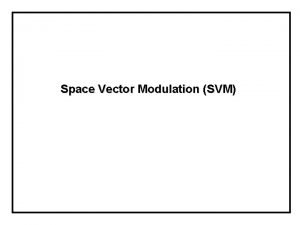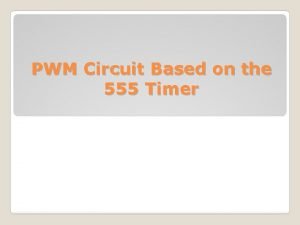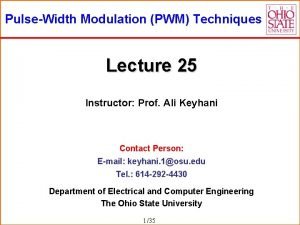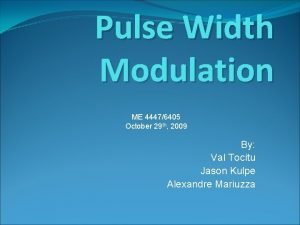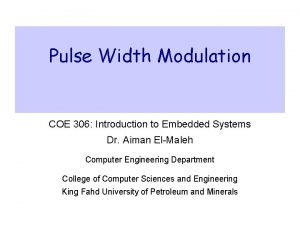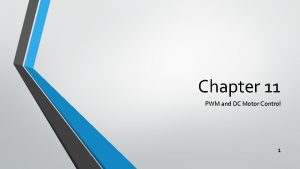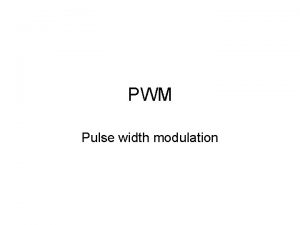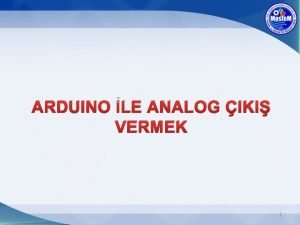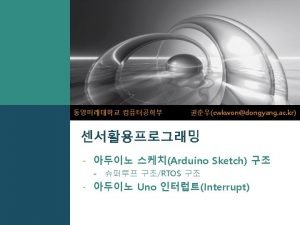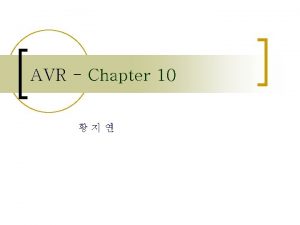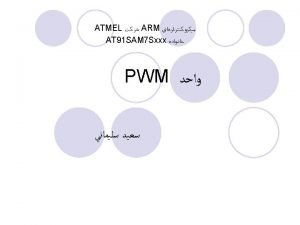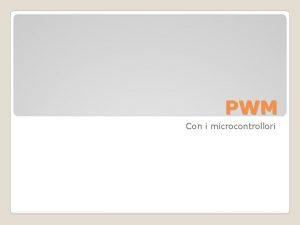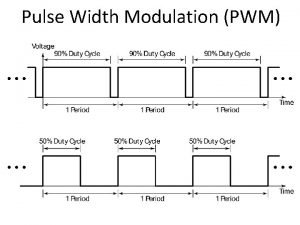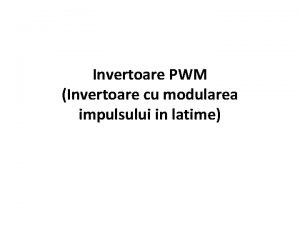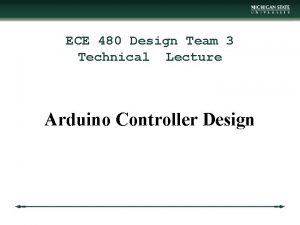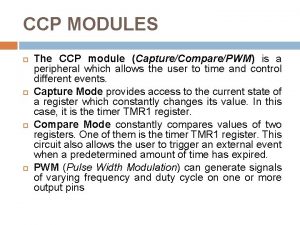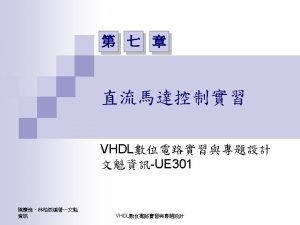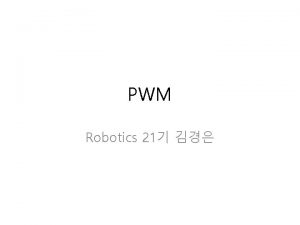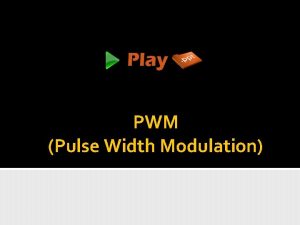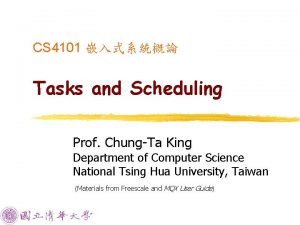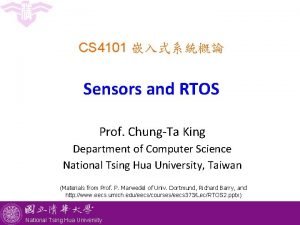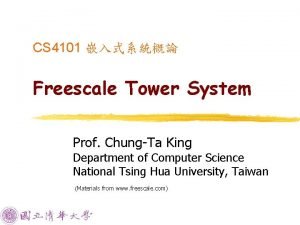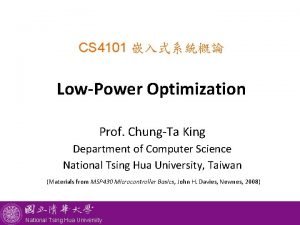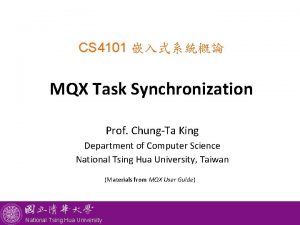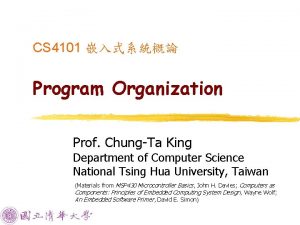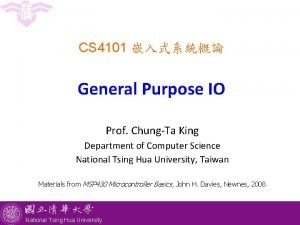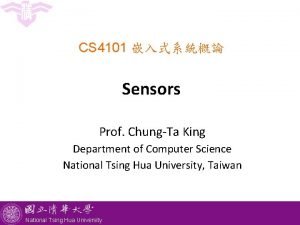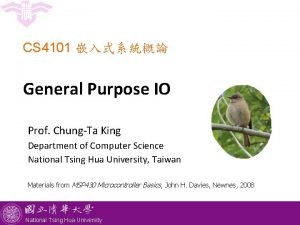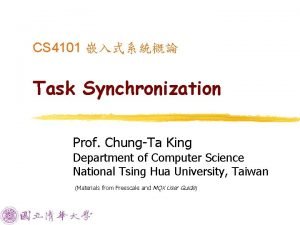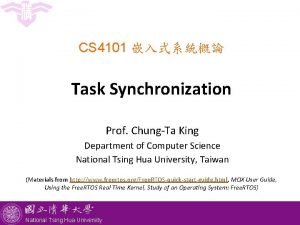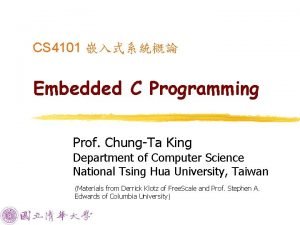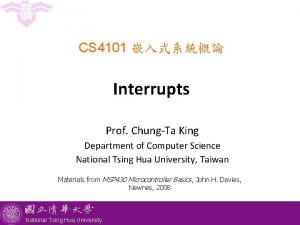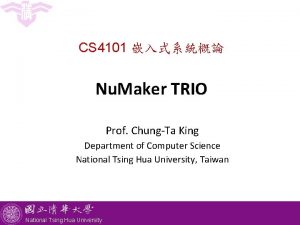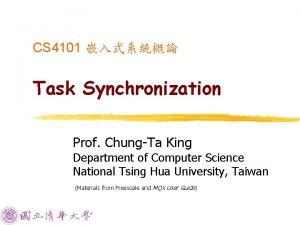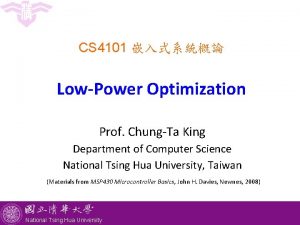CS 4101 DAC and PWM Prof ChungTa King






















- Slides: 22

CS 4101 嵌入式系統概論 DAC and PWM Prof. Chung-Ta King Department of Computer Science National Tsing Hua University, Taiwan National Tsing Hua University

Outline • Introduction to digital-to-analog converter (DAC) • Pulse-width modulation (PWM) • Introduction to stepper motor National Tsing Hua University 1

ADC • We have learned that we can quantify a nature value by ADC. Analog signal Digital signal • We can also transform digital value into analog signals, e. g. control motors, generate sounds, . . . Analog signal Binary input National Tsing Hua University IN DAC OUT 2

Digital-to-Analog Converter (DAC) • DAC converts digital values into analog signals by producing different proportions of voltage according V to the binary input. ref - Voltage can be generated by modifying different resistors V 1 R V 2 2 R V 3 4 R Vn I Rf + Vout 2 n-1 R MSB LSB (D. Hinckley, L. Huynh, D. Kim) National Tsing Hua University 3

DAC Example – RGB LED • If we give LED more power, it will be brighter. So we can use this feature to intensify Red, Blue and Green diode through a DAC. National Tsing Hua University 4

RGB LED Animation Reference : Matthew Beckler's Home Page (https: //www. mbeckler. org/microcontrollers/rgb_led/) National Tsing Hua University 5

Outline • Introduction to digital-to-analog converter (DAC) • Pulse-width modulation (PWM) • Introduction to stepper motor National Tsing Hua University 6

Pulse-width Modulation (PWM) • We can use DAC to control the output voltage, but this usually requires an additional chip. • Pulse-width modulation (PWM) provides the ability to simulate varying levels of outputs. Thus, we can use PWM to convert digital signals into analog intensities without DAC. National Tsing Hua University 7

Pulse-width Modulation • A PWM signal: - Different duty cycles imply different average power. - Duty Cycle = (PW/T) * 100%, where PW is pulse width time and T is total period of a signal. - Ex. : A 90% duty cycle means the signal is high 90% of the time and low 10% of the time. National Tsing Hua University 8

Example of Duty Cycle • If high voltage = 5 V and duty cycle = 10%, then the average output voltage = 0. 5 V National Tsing Hua University 9

PWM for Driving RGB LED (https: //developer. mbed. org/users/4180_1/notebook/rgb-leds/) National Tsing Hua University (https: //www. pjrc. com/teensy/rgb_led. gif) 10

PWM in Arduino • 6 pins, 3, 5, 6, 9, 10, 11, marked by ~ can produce PWM output via analog. Write(pin. Number, duty. Cycle) National Tsing Hua University 11

PWM in Arduino - analog. Write() • analog. Write(pin, value) - Writes an analog value (PWM wave) to a pin. - Value specifies the duty cycle between 0 (always off) and 255 (always on). - Pin will generate a steady square wave of the specified duty cycle until the next call to analog. Write(). • The frequency of the PWM signal on most pins is approximately 490 Hz. - On Arduino UNO, pins 5 and 6 have a frequency of approximately 980 Hz. National Tsing Hua University 12

Outline • Introduction to digital-to-analog converter (DAC) • Pulse-width modulation (PWM) • Introduction to stepper motor National Tsing Hua University 13

Stepper Motor • An electromagnetic device that - Converts digital pulses into mechanical shaft rotation - Ex. analog clock • Precision - Determined primarily by the number of steps per revolution (coecsl. ece. illinois. edu/ge 423/sensorprojects/Step. Motor. ppt) National Tsing Hua University 14

Stepper Motor • Controlled by a series of electromagnetic coils - The coils are alternately given current. - The creating magnetic fields will repulse or attract the magnets on the shaft, causing the motor to rotate. (http: //www. electronics-tutorials. ws/io/io_7. html) National Tsing Hua University 15

Example Stepper Motor: 28 BYJ-48 • Number of phases: 4 • Step angle: - 8 -step sequence: 5. 625° (64 steps per revolution) - 4 -step sequence: 11. 25° (32 steps per revolution) • Gear reduction ratio: 1/64 - 32*64 = 2048 steps per revolution in 4 -step sequence National Tsing Hua University 16

Stepper Motor Driver • The output voltage provided by Arduino UNO cannot drive 28 BYJ-48. • So we need to use an amplifier, ULN 2003, to raise the output voltage. 4 LEDs indicate which coil is currently powered National Tsing Hua University 17

Drive Methods • Different drive methods for stepper motors. 1 -phase excitation 2 -phase excitation • Different methods cause different shakiness, power consumption and accuracy. National Tsing Hua University 18

Stepper. c • Arduino stepper library uses 2 -phase excitation to rotate the motor. National Tsing Hua University 19

Sample Code for Stepper Motor #include <Stepper. h> // change this to the number of steps on your motor #define STEPS 100 // create an instance of the stepper class, specifying # of steps of the motor and the pins it is attached to Stepper stepper(STEPS, 8, 9, 10, 11); // the previous reading from the analog input int previous = 0; void setup() { stepper. set. Speed(30); // set the speed to 30 RPMs } National Tsing Hua University 20

Sample Code for Stepper Motor void loop() { // get the sensor value from analog input A 0 int val = analog. Read(A 0); // move a number of steps equal to the change in the // sensor reading stepper. step(val - previous); // remember the previous value of the sensor previous = val; } National Tsing Hua University 21
 Chungta
Chungta Chungta
Chungta Ipc 4101b 126
Ipc 4101b 126 Vde ar n 4101
Vde ar n 4101 Svm pwm
Svm pwm Genilik
Genilik Pwm 555 circuit
Pwm 555 circuit Space vector pwm
Space vector pwm Advantages of pwm
Advantages of pwm Pwm in embedded system
Pwm in embedded system Pwm in embedded system
Pwm in embedded system Pulsos: pam, ppm, pwm, pcm, ask, fsk, psk, qam
Pulsos: pam, ppm, pwm, pcm, ask, fsk, psk, qam Pwm center aligned
Pwm center aligned Contoh aplikasi pwm
Contoh aplikasi pwm Arduino pwm örnek
Arduino pwm örnek 인터럽트 예시
인터럽트 예시 Atmega128 타이머/카운터 예제
Atmega128 타이머/카운터 예제 Block diagram of pwm
Block diagram of pwm Pwm arduino frequenza
Pwm arduino frequenza What is pulse width modulation
What is pulse width modulation Semnal pwm definitie
Semnal pwm definitie Pwm arduino ø´ø±ø
Pwm arduino ø´ø±ø Ccp module
Ccp module
